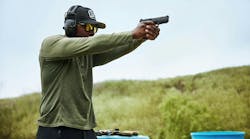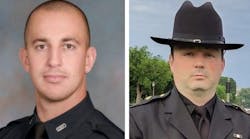Law enforcement leaders have been trying for years to put a stop to fatal police-on-police shootings like the one involving two BART detectives last week in a Dublin apartment - incidents that are rare but represent a nightmarish collision of the risks inherent in the job.
But those who have studied the shootings say there are a variety of reasons why they occur, and no concrete answer as to whether training can prevent them.
"Blue on blue" shootings can come in many forms: an officer accidentally discharges a weapon, fires at a suspect only to have a stray bullet hit a colleague, or momentarily views a colleague as hostile during a tense situation.
Particularly alarming have been cases in which African American officers are shot while off-duty or working undercover, raising the specter of racial profiling. Shooting simulators have found that cops as well as civilians are quicker to shoot images of black gunmen than white gunmen.
"You can train for a lot of possibilities, but there's always the impossible that occurs that you didn't train for," said Don Cameron, a former officer for BART and the city of Berkeley who now trains officers. "There's one variable that wasn't there in the training, and you never know what it is. Unfortunately, when the scenario comes up, it's like, 'Whoa, we didn't train for this.' "
Mistook sergeant for threat
Sources have told The Chronicle that BART police Officer Michael Maes mistook his supervisor, Sgt. Tom "Tommy" Smith, 42, for an armed threat when they unexpectedly came across each other during a probation search in Dublin on Tuesday. But the scenario was anything but typical for a friendly-fire shooting.
The men, both white, were in plainclothes, and they knew each other well. They and a third detective, plus two uniformed BART officers, had entered a cramped one-bedroom apartment inhabited by a robbery suspect who was already in custody.
The 723-square-foot unit had a circular layout, with the bathroom accessible from the bedroom and a laundry area near the front door. Maes fired once, striking Smith in the chest.
Trying to avoid repeats
Investigations by several agencies will look into whether the BART officers used proper tactics during the search, and could prompt recommendations on ways to avoid a repeat of the tragedy.
"Anytime there is a critical incident for law enforcement, there should always be a look-back at what occurred to see if anything could be done better," said Mark Smith, the independent auditor for the BART Police Department. "It's our goal to make sure that the investigation looks at every aspect of the incident, from start to finish, for anything that can be improved as far as tactics, safety or any other matter."
Concern about the friendly-fire deaths of two off-duty black officers in New York in 2008 and 2009 led then-Gov. David Paterson to convene a task force to study the issue. Its report said there had been 26 fatal incidents from 1981 to 2009 in which police officers were shot by colleagues who had mistaken them for criminals.
"Most police-on-police shootings are preventable, but only if supervisors, trainers and officers themselves understand how they have happened in the past," the report said.
The authors noted that there were far more nonfatal confrontations - "near misses" - involving police who came close to shooting a colleague but "at the last split second didn't shoot for some reason or another," said Geoffrey Alpert, a criminology professor at the University of South Carolina who participated in the study.
"That happens more than you want to know," Alpert said in an interview.
In one incident in San Francisco in 1991, four police officers split into two teams to look for a suspect in a hotel, with one team taking along civilian hotel employees. One worker felt resistance while opening a stairwell door, looked through the opening and saw the hand of a man with a gun. Another officer shot and wounded the gunman - who turned out to be a fellow officer.
"The most important way to stop it is planning," Alpert said. "The more communication and more training you have, the less likely this is going to occur."
Plainclothes officer's death
The most recent fatal accidental police shooting in the Bay Area happened in 2001, when two rookie Oakland police officers shot and killed plainclothes Officer William "Willie" Wilkins, whom they mistook for an armed threat holding someone at gunpoint. The two rookie officers hadn't recognized Wilkins, who was Latino, and told investigators they reacted to the gun he was pointing.
One of the officers who shot Wilkins, Andrew Koponen, extended his sympathies Saturday to the families of Smith and Maes.
"The facts are that both officers, as they have done for many years, were doing their jobs to create a safer place for us from the violent criminals who prey upon the Bay Area," Koponen said. "Give the officers and their families time to heal, which amounts to months and years, not days and weeks."
Similar shootings
Although Koponen hadn't recognized Wilkins, similar shootings have involved officers who knew each other.
In 1993, the Orange County Sheriff's Office saw an impromptu training exercise go terribly wrong. Deputy Darryn Robins surprised a fellow deputy when - while playing the part of an assailant - he suddenly reached for a gun from the visor of his patrol car, prompting the other deputy to shoot and kill him. Robins was black, and the shooter, Brian Scanlan, was white.
Those situations underscore the reality that officers often instinctively fire when they see a weapon, believing they are in mortal danger, without necessarily focusing on exactly who is holding that weapon, Cameron said.
"He doesn't look at the individual, he looks at the gun," Cameron said. "It's natural for an officer to do that, because you're always looking for the hands. You don't see the person, you really don't. You see the gun."
Expanding training
Cameron said that in instances in which an officer mistakenly kills a fellow officer known to him, investigators will look at whether the two had split up before crossing paths unexpectedly, or if one officer was somehow "spooked" by the sight of another officer with a gun.
The task force convened after the New York shootings focused many of its recommendations on beefing up training. The experts, who included San Francisco District Attorney George Gascón, said the training should be interactive, with scenarios that include confrontations between officers.
The report also called for more support for agencies after they go through a fatal police-on-police shooting. The incidents can erode public confidence in police, the authors said, and can "easily traumatize and sometimes polarize entire police departments."
Copyright 2014 San Francisco Chronicle
McClatchy-Tribune News Service



